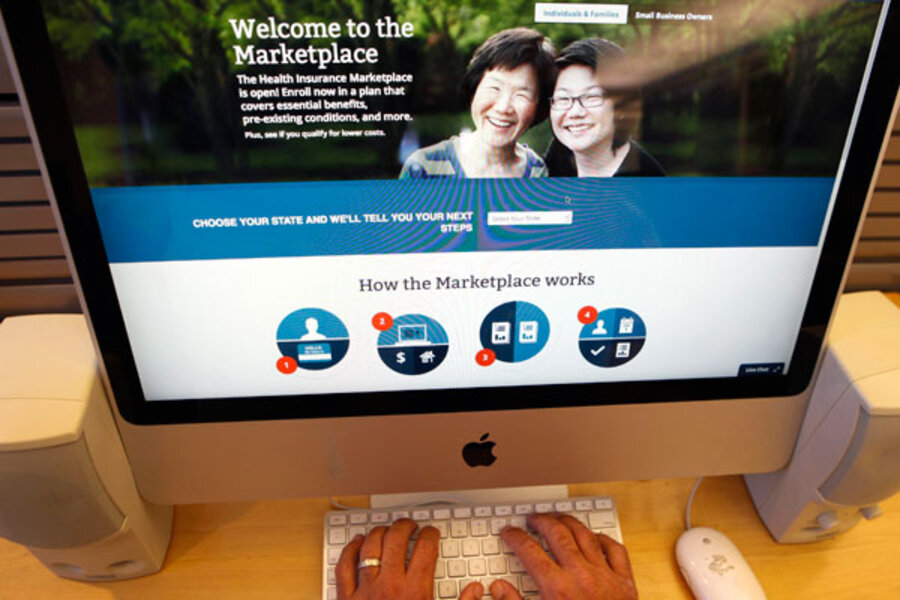Obamacare website security called 'outrageous': How safe is it?
Loading...
Cybersecurity professionals are voicing questions about potential red flags in the new federal health care website system that could open the door to theft of personal information.
In the two weeks since the Affordable Healthcare Act site, www.healthcare.gov, went live, most complaints have centered on long wait times with sites initially overloaded by interested visitors. In response, government officials are scrambling to get more capacity for the main site and its satellites.
But potentially far more serious questions are emerging about cybersecurity. Experts have said that hackers could “spoof” the website with a look-alike website to collect personal information, or criminals could use an automated program to try repeatedly to enter the site even if it didn’t get a login correct.
Experts have stopped short of calling these concerns “vulnerabilities” – a term that means a proven weak spot to hackers. But they say these red flags need attention.
“I’ll ask you your Social Security, your date of birth, [so] an hour later I can empty your bank account,” John McAfee, who founded the cybersecurity company of the same name but is no longer associated with it, complained on Fox News. The Obamacare websites, he said, have “no safeguards,” and the main site's architecture is "outrageous."
Federal officials say they have made website security a “top priority,” said Marilyn Tavenner, administrator for the Centers for Medicare & Medicaid Service, which operates the system, during a congressional hearing in July. “We will use appropriate policies, procedures, standards, and implementation specifications to ensure the privacy and security of consumer data in accordance with applicable law.”
For example, the site is supposed to adhere to cybersecurity standards for the federal government set by the National Institute of Standards and Technologies.
But just because all the standards are met does not mean all the holes are plugged. Some cybersecurity experts have echoed Mr. McAfee's comments. Here are some of the red flags they raise.
Request forgery. One potential flaw with the Obamacare website would grant automated “all-Access Request For Other Sites” – which basically allows another site to make a certain kinds of request to healthcare.gov that could lead to “cross-site request forgery” and potentially fooling the government site into releasing restricted information, writes Nidhi Shah, who works on research and development for HP's Web Security Research Group, on a company blog. That red flag appeared on some of the site's pages, but she admits it could not be confirmed at the time on the site’s most secure areas because of high traffic volume.
'Clickjacking.' The government site lacks defenses to prevent an attacker from putting an invisible layer over the legitimate website, Ms. Shah added. As a result, a user clicking on a link or button might end up at a renegade site that looked just the same – and end up divulging personal information to that site.
'Cookie theft.' The site appears not to use a feature that prevents access to cookies that are stored on a user’s personal computer. "Healthcare.gov uses cookies to maintain user history on the site and [for] user identification," Shah writes. At the very least, an attacker could grab "sensitive information such as ... possible health issues, income level, and marital status.”
Verification. A more fundamental problem is the way the website is set up, contends Christopher Budd, communications manager for Trend Micro, a Tokyo-based cybersecurity company. "The health insurance exchange isn't made up of a single, authoritative site where people can go and register for coverage," he wrote in a blog post. "In addition to the federal site, people can apply for coverage at sites run by individual states. Then, within each state, there can also be legitimate third-party sites that provide assistance and even broker coverage," he said.
While the main federal site uses a key security feature called SSL to verify itself, "a survey of state and third-party sites also shows that official sites aren't required to provide the ability to verify the site using SSL," he writes. Many of those sites don’t authenticate, he said.
"As people look for health care exchanges, they're going to be faced with potentially hundreds or thousands of sites that claim to be legitimate, but [they] won't be able to easily verify that claim," except based on how a site looks, Mr. Budd wrote.
Login fraud. Basic problems with the site could invite cybercriminals to use automated systems to hack individual accounts, according to researchers at TrustedSec in Strongsville, Ohio. They noted that there were no features to prevent an intruder from using an automated program to try repeatedly to enter the site even if it didn’t get a login try correct. Common tools are available to authenticate that a human is trying to make the attempted login, such as putting on the screen with a word that only a human can read – that would then have to be typed into a box.
“As you can imagine, the site is going to be a major target for hackers, other governments, and organized crime,” the TrustedSec researcher wrote. “There’s a lot of money to be made right now in an untapped market that is fresh for the picking.”








